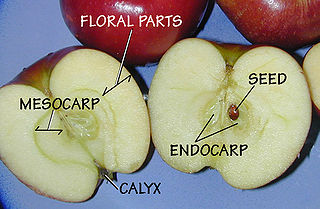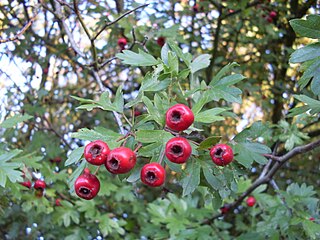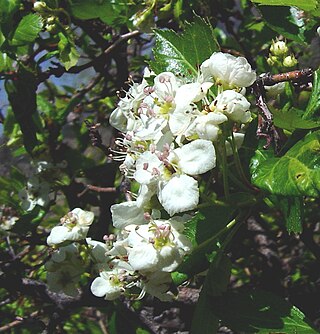
Crataegus, commonly called hawthorn, quickthorn, thornapple, May-tree, whitethorn, Mayflower or hawberry, is a genus of several hundred species of shrubs and trees in the family Rosaceae, native to temperate regions of the Northern Hemisphere in Europe, Asia, North Africa and North America. The name "hawthorn" was originally applied to the species native to northern Europe, especially the common hawthorn C. monogyna, and the unmodified name is often so used in Britain and Ireland. The name is now also applied to the entire genus and to the related Asian genus Rhaphiolepis.

In botany, a pome is a type of fruit produced by flowering plants in the subtribe Malinae of the family Rosaceae. Pome fruits consist of a central "core" containing multiple small seeds, which is enveloped by a tough membrane and surrounded by an edible layer of flesh. Pome fruit trees are deciduous, and undergo a dormant winter period that requires cold temperatures to break dormancy in spring. Well-known pomes include the apple, pear, and quince.

Crataegus monogyna, known as common hawthorn, one-seed hawthorn, or single-seeded hawthorn, is a species of flowering plant in the rose family Rosaceae. It is native to Europe, northwestern Africa, and Western Asia, but has been introduced in many other parts of the world.

Mespilus germanica, known as the medlar or common medlar, is a large shrub or small tree in the rose family Rosaceae. The fruit of this tree, also called medlar, has been cultivated since Roman times, is usually available in winter and eaten when bletted. It may be eaten raw and in a range of cooked dishes. When the genus Mespilus is included in the genus Crataegus, the correct name for this species is Crataegus germanica (Kuntze). In the southwest of England it historically had a number of vulgar nicknames, such as open-arse and monkey's bottom, due to the appearance of its large calyx.

Crataegus heterophylla, known as the various-leaved hawthorn, is of uncertain origin. Its original native range is not known, possibly it was the Caucasus of Western Asia. Suggestions that it originated in Southeast Europe may be based on misidentification.

Crataegus laevigata, known as the Midland hawthorn, English hawthorn, woodland hawthorn, or mayflower, is a species of hawthorn native to western and central Europe, from Great Britain and Spain east to the Czech Republic and Hungary. It is also present in North Africa. The species name is sometimes spelt C. levigata, but the original orthography is C. lævigata.
Crataegus brachyacantha is one of the "black-fruited" species of hawthorn, but it is only very distantly related to the other black-fruited species such as C. douglasii or C. nigra. The common names blueberry haw and blueberry hawthorn refer to the appearance of the fruit, which are almost blue, and does not refer to their taste. The species is rarely cultivated but has ornamental leaves, flowers, and foliage. It is native to Louisiana, and also occurs just across the border of neighbouring states.

Crataegus chrysocarpa is a species of hawthorn that is native to much of the continental United States and Canada. Common names fireberry hawthorn and goldenberry hawthorn, as well as the scientific name all refer to the colour of the unripe fruit, although the mature fruit is red and in var. vernonensis is "deep claret-colored … nearly black when over-ripe".

Crataegus crus-galli is a species of hawthorn known by the common names cockspur hawthorn and cockspur thorn. It is native to eastern North America from Ontario to Texas to Florida, and it is widely used in horticulture. It is thought to be the parent, along with Crataegus succulenta, of the tetraploid species Crataegus persimilis.

Crataegus erythropoda is a hawthorn native to the southern Rocky Mountains in the United States. The leaves are conspicuously shiny above and fruit ("haws") are dark purplish red. It is seldom cultivated, but at one time was listed in the nursery trade under the common name "Chocolate Haw". It is closely related to C. rivularis which has fruit that are fully black when ripe.

Crataegus orientalis, known as oriental hawthorn, is a species of hawthorn native to the Mediterranean region, Turkey, Caucasia, Crimea, and western Iran, with fruits that are orange or various shades of red.

Crataegus punctata is a species of hawthorn known by the common names dotted hawthorn or white haw that is native to most of the eastern United States and eastern Canada. While some sources claim it is the state flower of Missouri, the actual legislation does not identify an exact species. Furthermore, the Missouri Department of Conservation asserts the Crataegus mollis was specifically designated as the state flower.

Crataegus rhipidophylla is a species of hawthorn which occurs naturally from southern Scandinavia and the Baltic region to France, the Balkan Peninsula, Turkey, Caucasia, and Ukraine. It is poorly known as a landscape and garden plant, but seems to have potential for those uses.

Crataegus mexicana is a species of hawthorn known by the common names tejocote, manzanita, tejocotera and Mexican hawthorn. It is native to the mountains of Mexico and parts of Guatemala, and has been introduced in the Andes. The fruit of this species is one of the most useful among hawthorns.

Crataegus × sinaica is a hawthorn that originated as a hybrid between two other hawthorn species, C. azarolus in series Orientales and C. monogyna in series Crataegus. It has been placed in the nothosection Orientaegus. It grows in the central and eastern parts of the Mediterranean region on rocky mountain slopes. In Egypt it grows in the mountains near Saint Catherine in South Sinai, where it is known as za'rur or za'rur al-awdiyah.
Stigmella oxyacanthella is a moth of the family Nepticulidae, found in Europe and North America. The larvae are leaf miners feeding inside the leaves of trees and shrubs, such as hawthorn, apple and pear.

The Maleae are the apple tribe in the rose family, Rosaceae. The group includes a number of plants bearing commercially important fruits, such as apples and pears, while others are cultivated as ornamentals. Older taxonomies separated some of this group as tribe Crataegeae, as the Cydonia group, or some genera were placed in family Quillajaceae.

Malinae is the name for the apple subtribe in the rose family, Rosaceae. This name is required by the International Code of Nomenclature for algae, fungi, and plants, which came into force in 2011 for any group at the subtribe rank that includes the genus Malus but not either of the genera Rosa or Amygdalus. The group includes a number of plants bearing commercially important fruits, such as apples and pears, while others are cultivated as ornamentals.





















